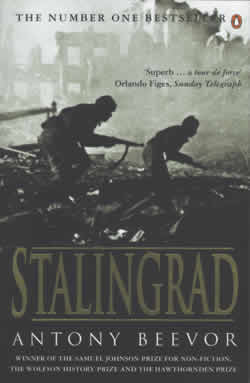
The Stalingrad siege
Book review by Fred Lane
Beevor, A. (1998) Stalingrad. Penguin Books. 494pp, including maps, photos, index and comprehensive chapter footnotes. Paperback $35
Retired British Army officer Antony Beevor won many literary prizes and reviewer acclaim with this book. Together with Harrison Salisbury’s description of the 900-day siege of Leningrad (Salisbury 1969) and John Erikson’s version of Stalingrad (Erikson 2003), these books graphically illustrate the ghastly carnage of the truly world-shaping Ostfront battles.
Before the Germans fired their first Operation Barbarossa shot on 21 June 1941, the Red Army was slowly recovering from the loss of no less than 36,671 officers executed in a senseless Stalinist political purge. Of 706 officers of brigade commander or higher rank, a mere 303 remained.
Political meddling
Time and time again, military disaster and unnecessary casualties followed operational meddling by both Stalin and Hitler. Compared with the losses reported in the recent Afghanistan and Iraq wars, the wanton sacrifice of human life and suffering is mind-boggling.
In the first three weeks of Barbarossa, the Red Army reported losses of 3,500 tanks, 6,000 aircraft and two million men. Within the first three months another 3,000 tanks had been lost and the Germans had captured 965,000 prisoners. To this must be added hundreds of thousands of civilian casualties from Hitler’s Rassen-kamp (Race War).
The German Army reported 400,000 of their own casualties in the same period. All this was well before they invested Stalingrad and the bitter 1941/42 Russian winter.
Operation Blue
After a pause, due mainly to Hitler denying his armies equipment for Russian winter warfare, Operation Blue shattered Russian defensive lines in June 1942. By 23 August, 16th Division Panzers had established themselves on the Volga just to the north of Stalingrad.
Stalingrad, at that stage, was the third largest city in the Soviets. Although 60,000 of its civilians were transported for slave labour in Germany, about 10,000, including 1,000 children, remained and survived the five month-long battle. Some were evacuated to safety across the Volga, but it was a deliberate and callous top-level Stavka policy to leave civilians in the battlefield. Many civilians attempted to escape, but like fellow army deserters were summarily executed by NKVD and other troops. Stalingrad’s civilians, including children, were used by both sides to dig fortifications, spy and carry supplies.
However, it is the graphic saga of the dogged defence of Stalingrad that is the main subject of this book. Eyewitness accounts give new meaning to “total war”.
Until Stalingrad and Leningrad, the Russian campaign was marked by chaotic logistics and even worse leadership. In contrast the Germans noted that many individual groups of isolated Soviet soldiers in rear areas fought for weeks, without supplies, “long after others would have surrendered”.
In Stalingrad, the Russian strategy of turning nearly every pile of rubble into either a fortress or a barricade from which to mount repeated counter-attacks paid off. It was not unusual to have one floor of a building occupied by Germans, another by Russian forces, fighting each other. This kind of battle might ebb and flow for days at a time, with no hope of tank, artillery or air support from either side. Sewers, tunnels and air spaces above ceilings all became major tactical objectives. This strategy nullified German superiority in mechanised movement and air warfare. Although the first air assaults of more than 1500 sorties a day killed some 40,000 Stalingrad civilians, they also set the stage for the ensuing infantry battles by providing streets of rubble and leaving only the sturdiest structures standing.
Sailors fight as infantry
Russian sailors, fighting as infantry, were prominent in a number of vital actions. One brigade had been sent across Siberia from the Far East Fleet. Their officers were chiefly 18-year old cadets from Leningrad, who were given three weeks Army training on their way south before linking with their men. One of the sailors’ major defensive positions was a big square grain silo, which they held against tremendous odds and repeated assaults.

On 14 October the Germans launched all-out attacks on the remnants of the Dzerzhinsky Tractor Factory. They were met by mines, dug-in T-34 tanks and 45 mm and 96 mm anti-tank guns concealed in the rubble. The factory was over-run at great cost, but pockets of resistance lasted for days, from which counter-attacks emerged at night. The German effort petered out towards the end of October due chiefly to exhaustion and lack of ammunition. A renewed offensive launched 11 November met a similar fate.
Meanwhile, Generals Georgy Zhukov and Alexandr Vasilevsky, back in Moscow, developed Operation Uranus, a brilliant counterstroke aiming to cut off all the German forces besieging Stalingrad. Launched on 11 November, chiefly against Romanian troops guarding the German 6th Army’s northern flank, 100 to 150km west of Stalingrad, it linked up with a bold thrust from the south and closed the trap 11 days later.
Despite bombastic Luftwaffe assurances, the trapped army could not be resupplied by air. Hitler’s chief response was to issue gallantry medals and he twice promoted Paulus, the 6th Army’s commander. Aware that no German Field Marshal had ever been captured alive, Paulus, on receiving this promotion just two days before his surrender announced, “I have no intention of shooting myself for this Bohemian corporal.” The entire German 6th Army was captured or killed. It comprised about 290,000 souls and included between 50,000 and 70,000 Hiwis (Ukranian and other Soviet forced labourers and collaborators).
Very few survivors
Very few of the diseased and emaciated German soldiers captured in this action survived their imprisonment and even fewer Hiwis saw the war’s end. In brutal retribution many were clubbed to death, ostensibly to save ammunition.
This well-written book is an essential text for anyone interested in the mechanics of large scale street warfare.
References:
Erikson, J. The road to Stalingrad. Orion Publishing Co: London, 2003.
Salisbury, H.E. The 900 days: The siege of Leningrad. Pan Books: London, 1969.
